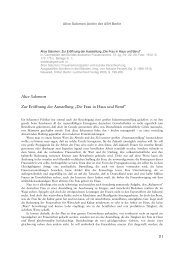Teaching Gender in Social Work - MailChimp
Teaching Gender in Social Work - MailChimp
Teaching Gender in Social Work - MailChimp
Create successful ePaper yourself
Turn your PDF publications into a flip-book with our unique Google optimized e-Paper software.
ate. Natalist policies may be <strong>in</strong>troduced overtly as <strong>in</strong> the case of Ch<strong>in</strong>a (the onechild<br />
policy) or Romania (a series of coercive measures to achieve higher fertility,<br />
with severe restrictions on access to abortion and economic sanctions on childless<br />
persons), or covertly, as <strong>in</strong> the case of the United States (a pro-natalist policy).<br />
Birth rates have been decl<strong>in</strong><strong>in</strong>g s<strong>in</strong>ce the n<strong>in</strong>eteenth century, and are <strong>in</strong>fluenced<br />
by <strong>in</strong>dustrialisation, urbanisation and the development of the welfare<br />
state. 12 Juliet C. W. Mitchell 13 remarks that <strong>in</strong> the late n<strong>in</strong>eteenth century<br />
Western societies experienced simultaneously a sharp decl<strong>in</strong>e <strong>in</strong> fertility and the<br />
rise of fem<strong>in</strong>ism, which as well as its dom<strong>in</strong>ant struggle for the vote, stressed<br />
the urgency of effective birth control. She argues there are many <strong>in</strong>terrelated<br />
and different causes and that there exists a relationship between decl<strong>in</strong><strong>in</strong>g<br />
fertility and the <strong>in</strong>tensification of demands for the equal rights of women.<br />
Decl<strong>in</strong><strong>in</strong>g fertility is related to improvements <strong>in</strong> contraception and access to<br />
legal abortion. 14 Today’s demographic transition, the social position of women<br />
and fem<strong>in</strong>ist political movements are <strong>in</strong>timately connected. More competitive<br />
labour markets, low-wage work, ris<strong>in</strong>g hous<strong>in</strong>g costs, child-care dilemmas,<br />
and concerns about gender equity and marriage <strong>in</strong>stability are discourag<strong>in</strong>g<br />
some people to have any children or encourag<strong>in</strong>g others to limit their family<br />
size. These economic and social pressures shape people’s choices concern<strong>in</strong>g<br />
their reproduction issues. Delayed and reduced fertility may be beneficial to<br />
women’s employment and self-development but still may be perceived as a<br />
loom<strong>in</strong>g crisis for some nations. 15<br />
Violation of Reproduction Rights<br />
Reproductive justice means the right to have a child as well as the right not<br />
to have a child. Nidhi Trehan and Isabel Crowhurst 16 remark that historically,<br />
concern<strong>in</strong>g reproductive rights, women’s bodies are critically contested sites of<br />
12<br />
Beaujot, 2000, cited <strong>in</strong> Maureen Baker, “Restructur<strong>in</strong>g reproduction: <strong>in</strong>ternational and national pressures”. Journal<br />
of Sociology 44, (2008): 65–81.<br />
13<br />
Juliet C. Mitchell. “Procreative mothers (sexual difference) and child free sisters (gender): fem<strong>in</strong>ism and fertility.”<br />
European Journal of Women’s Studies 11, (2004): 415–426.<br />
14<br />
Baker, 2008.<br />
15<br />
Ibid.<br />
16<br />
Nidhi Trehan and Isabel Crowhurst, “M<strong>in</strong>ority groups and reproductive rights,” <strong>in</strong> Women’s reproductive rights:<br />
Women’s rights <strong>in</strong> Europe, ed. Heather Widdows, Itziar Alkorta Idiakez and Aitziber Emaldi Cirión (Palgrave Macmillan,<br />
2006), 111–116.<br />
149














